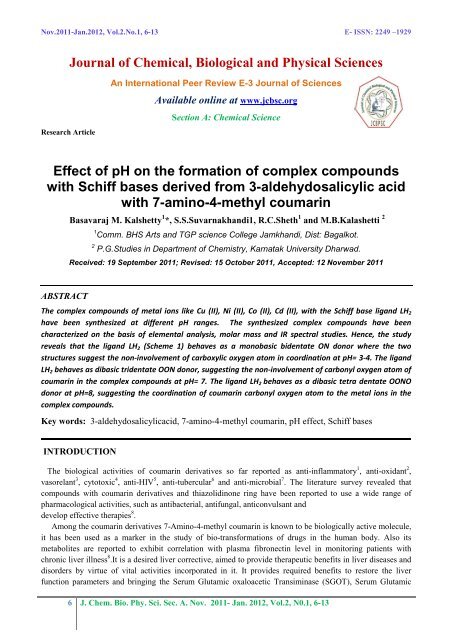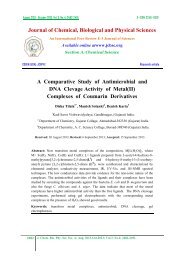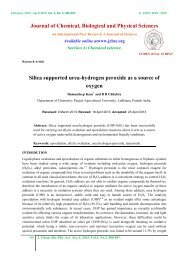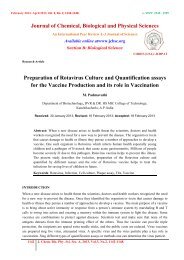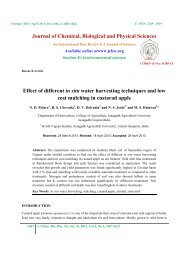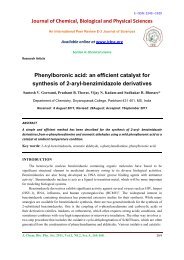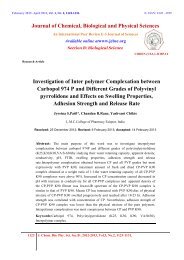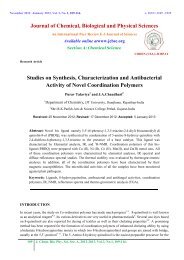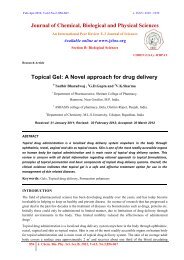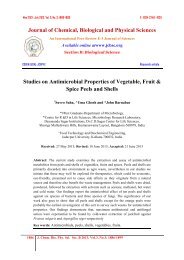Effect of pH on the formation of complex compounds with Schiff ...
Effect of pH on the formation of complex compounds with Schiff ...
Effect of pH on the formation of complex compounds with Schiff ...
Create successful ePaper yourself
Turn your PDF publications into a flip-book with our unique Google optimized e-Paper software.
Nov.2011-Jan.2012, Vol.2.No.1, 6-13 E- ISSN: 2249 –1929Journal <str<strong>on</strong>g>of</str<strong>on</strong>g> Chemical, Biological and Physical SciencesAn Internati<strong>on</strong>al Peer Review E-3 Journal <str<strong>on</strong>g>of</str<strong>on</strong>g> SciencesResearch ArticleAvailable <strong>on</strong>line at www.jcbsc.orgSecti<strong>on</strong> A: Chemical Science<str<strong>on</strong>g>Effect</str<strong>on</strong>g> <str<strong>on</strong>g>of</str<strong>on</strong>g> <str<strong>on</strong>g>pH</str<strong>on</strong>g> <strong>on</strong> <strong>the</strong> formati<strong>on</strong> <str<strong>on</strong>g>of</str<strong>on</strong>g> <strong>complex</strong> <strong>compounds</strong><strong>with</strong> <strong>Schiff</strong> bases derived from 3-aldehydosalicylic acid<strong>with</strong> 7-amino-4-methyl coumarinBasavaraj M. Kalshetty 1 *, S.S.Suvarnakhandi1, R.C.Sheth 1 and M.B.Kalashetti 21 Comm. BHS Arts and TGP science College Jamkhandi, Dist: Bagalkot.2 P.G.Studies in Department <str<strong>on</strong>g>of</str<strong>on</strong>g> Chemistry, Karnatak University Dharwad.Received: 19 September 2011; Revised: 15 October 2011, Accepted: 12 November 2011ABSTRACTThe <strong>complex</strong> <strong>compounds</strong> <str<strong>on</strong>g>of</str<strong>on</strong>g> metal i<strong>on</strong>s like Cu (II), Ni (II), Co (II), Cd (II), <strong>with</strong> <strong>the</strong> <strong>Schiff</strong> base ligand LH 2have been syn<strong>the</strong>sized at different <str<strong>on</strong>g>pH</str<strong>on</strong>g> ranges. The syn<strong>the</strong>sized <strong>complex</strong> <strong>compounds</strong> have beencharacterized <strong>on</strong> <strong>the</strong> basis <str<strong>on</strong>g>of</str<strong>on</strong>g> elemental analysis, molar mass and IR spectral studies. Hence, <strong>the</strong> studyreveals that <strong>the</strong> ligand LH 2 (Scheme 1) behaves as a m<strong>on</strong>obasic bidentate ON d<strong>on</strong>or where <strong>the</strong> twostructures suggest <strong>the</strong> n<strong>on</strong>-involvement <str<strong>on</strong>g>of</str<strong>on</strong>g> carboxylic oxygen atom in coordinati<strong>on</strong> at <str<strong>on</strong>g>pH</str<strong>on</strong>g>= 3-4. The ligandLH 2 behaves as dibasic tridentate OON d<strong>on</strong>or, suggesting <strong>the</strong> n<strong>on</strong>-involvement <str<strong>on</strong>g>of</str<strong>on</strong>g> carb<strong>on</strong>yl oxygen atom <str<strong>on</strong>g>of</str<strong>on</strong>g>coumarin in <strong>the</strong> <strong>complex</strong> <strong>compounds</strong> at <str<strong>on</strong>g>pH</str<strong>on</strong>g>= 7. The ligand LH 2 behaves as a dibasic tetra dentate OONOd<strong>on</strong>or at <str<strong>on</strong>g>pH</str<strong>on</strong>g>=8, suggesting <strong>the</strong> coordinati<strong>on</strong> <str<strong>on</strong>g>of</str<strong>on</strong>g> coumarin carb<strong>on</strong>yl oxygen atom to <strong>the</strong> metal i<strong>on</strong>s in <strong>the</strong><strong>complex</strong> <strong>compounds</strong>.Key words: 3-aldehydosalicylicacid, 7-amino-4-methyl coumarin, <str<strong>on</strong>g>pH</str<strong>on</strong>g> effect, <strong>Schiff</strong> basesINTRODUCTIONThe biological activities <str<strong>on</strong>g>of</str<strong>on</strong>g> coumarin derivatives so far reported as anti-inflammatory 1 , anti-oxidant 2 ,vasorelant 3 , cytotoxic 4 , anti-HIV 5 , anti-tubercular 6 and anti-microbial 7 . The literature survey revealed that<strong>compounds</strong> <strong>with</strong> coumarin derivatives and thiazolidin<strong>on</strong>e ring have been reported to use a wide range <str<strong>on</strong>g>of</str<strong>on</strong>g>pharmacological activities, such as antibacterial, antifungal, antic<strong>on</strong>vulsant anddevelop effective <strong>the</strong>rapies 8 .Am<strong>on</strong>g <strong>the</strong> coumarin derivatives 7-Amino-4-methyl coumarin is known to be biologically active molecule,it has been used as a marker in <strong>the</strong> study <str<strong>on</strong>g>of</str<strong>on</strong>g> bio-transformati<strong>on</strong>s <str<strong>on</strong>g>of</str<strong>on</strong>g> drugs in <strong>the</strong> human body. Also itsmetabolites are reported to exhibit correlati<strong>on</strong> <strong>with</strong> plasma fibr<strong>on</strong>ectin level in m<strong>on</strong>itoring patients <strong>with</strong>chr<strong>on</strong>ic liver illness 8 .It is a desired liver corrective, aimed to provide <strong>the</strong>rapeutic benefits in liver diseases anddisorders by virtue <str<strong>on</strong>g>of</str<strong>on</strong>g> vital activities incorporated in it. It provides required benefits to restore <strong>the</strong> liverfuncti<strong>on</strong> parameters and bringing <strong>the</strong> Serum Glutamic oxaloacetic Transiminase (SGOT), Serum Glutamic6 J. Chem. Bio. Phy. Sci. Sec. A. Nov. 2011- Jan. 2012, Vol.2, N0.1, 6-13
<str<strong>on</strong>g>Effect</str<strong>on</strong>g> <str<strong>on</strong>g>of</str<strong>on</strong>g> <str<strong>on</strong>g>pH</str<strong>on</strong>g>....B. M. Kalshetty et al.Pyruic acid Transuminase (SGPT) to normal c<strong>on</strong>diti<strong>on</strong>, and it helps to restore <strong>the</strong> liver functi<strong>on</strong>ing byproviding multidimensi<strong>on</strong>al approach by showing anti-viral, anti-oxidant, anti-inflammatory, immunomodulatory,choleretic and anti-cholestatic activity 8 .The metal <strong>complex</strong>es are still a major line <str<strong>on</strong>g>of</str<strong>on</strong>g> approach to develop new drugs. It involves efforts to combine<strong>the</strong> separate pharmacophoric groups <str<strong>on</strong>g>of</str<strong>on</strong>g> similar activity into <strong>on</strong>e compound. Thus making structural changes in<strong>the</strong> biological activity. As reported earlier <strong>the</strong> thiazolidine ring present in a large number <str<strong>on</strong>g>of</str<strong>on</strong>g> biologically active<strong>compounds</strong> exhibiting different activities. The development <str<strong>on</strong>g>of</str<strong>on</strong>g> penicillin which shows <strong>the</strong> thiozoline ring.The present developments <str<strong>on</strong>g>of</str<strong>on</strong>g> 7-Amino-4-methyl coumarin <strong>compounds</strong> <strong>with</strong> metal i<strong>on</strong>s are most fascinatingand useful areas in medical chemistry. The discovery <str<strong>on</strong>g>of</str<strong>on</strong>g> coumarin as <strong>the</strong>rapeutic agents in 1820’s was <strong>the</strong>beginning <str<strong>on</strong>g>of</str<strong>on</strong>g> <strong>the</strong> coumarin drug development. Due to <strong>the</strong> diversified nature <str<strong>on</strong>g>of</str<strong>on</strong>g> coumarin and is completely safewhich renders as useful substance in drug research.Keeping in view <strong>the</strong> above importance <str<strong>on</strong>g>of</str<strong>on</strong>g> 7-Amino-4methyl coumarin and <strong>the</strong> c<strong>on</strong>tinuati<strong>on</strong> <str<strong>on</strong>g>of</str<strong>on</strong>g> work <strong>on</strong> <strong>the</strong>syn<strong>the</strong>sis <str<strong>on</strong>g>of</str<strong>on</strong>g> <strong>Schiff</strong> base derived from 3-Aldehydosalicylic acid and its <strong>complex</strong> <strong>compounds</strong> <strong>with</strong> metal i<strong>on</strong>ssuch as Cu (II), Zn (II), Ni (II), Co (II), and Cd (II) at different <str<strong>on</strong>g>pH</str<strong>on</strong>g>. The <strong>Schiff</strong> base compound (Scheme 1)syn<strong>the</strong>sized followed by standard procedures 9,10 c<strong>on</strong>tains <strong>the</strong> acidic groups such as –COOH and –OH(phenolic), it is predicted that <strong>the</strong> coordinati<strong>on</strong> behavior <str<strong>on</strong>g>of</str<strong>on</strong>g> ligand would be developed <strong>on</strong> <str<strong>on</strong>g>pH</str<strong>on</strong>g> using differentreacti<strong>on</strong> c<strong>on</strong>diti<strong>on</strong>s and are remarkably different from those reported by Nag et al 11 .,COOHCH 3OHHCNOOScheme-1: <strong>Schiff</strong> base ligand (LH2) 2-hydroxy-3-((4-methyl-2-oxo-2H-chromen-7-ylimino)methyl)benzoic acidResults and Discussi<strong>on</strong><strong>Schiff</strong> base ligands LH 2 (Scheme 1) was syn<strong>the</strong>sized by <strong>the</strong> standard methods 9, 10 . It is dark yellow incolor; it is sparingly soluble in water, in aqueous sodium hydroxide soluti<strong>on</strong>. But, readily soluble in alcohol(owing to <strong>the</strong> possessi<strong>on</strong> <str<strong>on</strong>g>of</str<strong>on</strong>g> <strong>the</strong> phenolic and carboxylic groups).The syn<strong>the</strong>sis <str<strong>on</strong>g>of</str<strong>on</strong>g> coordinati<strong>on</strong> <strong>compounds</strong><strong>with</strong> metal i<strong>on</strong>s at various <str<strong>on</strong>g>pH</str<strong>on</strong>g> ranges reported as follows:(I) At <str<strong>on</strong>g>pH</str<strong>on</strong>g>= 3-4: An aqueous or water-ethanol soluti<strong>on</strong> <str<strong>on</strong>g>of</str<strong>on</strong>g> <strong>the</strong> ligand LH 2 (Scheme 1) reacts <strong>with</strong> metal i<strong>on</strong>s in2:1 molar ratio forming metal <strong>complex</strong> <strong>compounds</strong> <str<strong>on</strong>g>of</str<strong>on</strong>g> <strong>the</strong> types [M(LH) 2 ] where M= Cu(II), Zn(II), Cd(II)(Scheme 2) and [M(LH) 2 (OH) 2 ] where M= Co(II), Ni(II) (Scheme 3). The formati<strong>on</strong>s <str<strong>on</strong>g>of</str<strong>on</strong>g> <strong>the</strong> <strong>complex</strong><strong>compounds</strong> at this <str<strong>on</strong>g>pH</str<strong>on</strong>g> range are shown below:MCl 2 (aq) + 2LH 2 (aq)[M (LH) 2 ] + 2 HCl...1Wher as M= Cu (II), Zn (II), Cd (II).andMCl 2 (aq) + 2LH 2 (aq) [M (LH) 2(H 2 O) 2 ]...2wher as M= Co (II), Ni (II).7J. Chem. Bio. Phy. Sci. Sec. A. Nov. 2011- Jan. 2012, Vol.2, N0.1, 6-13
<str<strong>on</strong>g>Effect</str<strong>on</strong>g> <str<strong>on</strong>g>of</str<strong>on</strong>g> <str<strong>on</strong>g>pH</str<strong>on</strong>g>....B. M. Kalshetty et al.(II). At <str<strong>on</strong>g>pH</str<strong>on</strong>g>= 7: <strong>the</strong> water-ethanol [50% (v/v)] soluti<strong>on</strong> <str<strong>on</strong>g>of</str<strong>on</strong>g> ligand LH 2 (Scheme 1) refluxed <strong>with</strong> alcoholicsoluti<strong>on</strong> <str<strong>on</strong>g>of</str<strong>on</strong>g> copper metal i<strong>on</strong> in 1:1 molar rati<strong>on</strong>, forming <strong>the</strong> <strong>complex</strong> compound <str<strong>on</strong>g>of</str<strong>on</strong>g> <strong>the</strong> type [CuL] 2 (Scheme4) at this <str<strong>on</strong>g>pH</str<strong>on</strong>g> range, shown below:CuCl 2 + 2LH 2 (aq)EtOHReflux[CuL]2 + 4HCl ...3In <strong>the</strong> same <str<strong>on</strong>g>pH</str<strong>on</strong>g> c<strong>on</strong>diti<strong>on</strong>, a ethanolic soluti<strong>on</strong> <str<strong>on</strong>g>of</str<strong>on</strong>g> ligand LH 2 reacts <strong>with</strong> alcoholic soluti<strong>on</strong> <str<strong>on</strong>g>of</str<strong>on</strong>g> metal i<strong>on</strong>s in 1:1molar ratio, forming <strong>the</strong> <strong>complex</strong> compound <str<strong>on</strong>g>of</str<strong>on</strong>g> <strong>the</strong> types [ML(EtOH)] where M= Zn(II), Cd(II) (Scheme 5),<strong>the</strong> formati<strong>on</strong> <str<strong>on</strong>g>of</str<strong>on</strong>g> <strong>the</strong> <strong>complex</strong> <strong>compounds</strong> at this <str<strong>on</strong>g>pH</str<strong>on</strong>g> range are shown below:MCl 2 (aq) + 2LH 2 (aq)EtOHReflux[ML(EtOH)] + HCl ...4M= Zn(II), Cd(II).a. At <str<strong>on</strong>g>pH</str<strong>on</strong>g>=8: <strong>the</strong> alcoholic soluti<strong>on</strong> <str<strong>on</strong>g>of</str<strong>on</strong>g> metal i<strong>on</strong>s react <strong>with</strong> an alcoholic soluti<strong>on</strong> <str<strong>on</strong>g>of</str<strong>on</strong>g> LH 2 (Scheme1) in 1:1molar ratio in <strong>the</strong> presence <str<strong>on</strong>g>of</str<strong>on</strong>g> sodium-ethoxide and forming <strong>the</strong> bimetallic <strong>complex</strong> <strong>compounds</strong> <str<strong>on</strong>g>of</str<strong>on</strong>g> <strong>the</strong>types [ML(EtOH)] 2 where M= Cu(II), Zn(II),Co(II),Ni(II), Cd(II) (Scheme 6).EtOH2 MCl 2 +2 LH 2 (aq)[ML(EtOH)] 2 + 4 HCl. ...5RefluxM= Cu(II), Zn(II),Ni(II),Co(II), Cd(II).All <strong>the</strong> syn<strong>the</strong>sized <strong>complex</strong> <strong>compounds</strong> were sparingly soluble in water but are fairly soluble in absolutealcohol.The analytical, molecular weight and o<strong>the</strong>r characterizati<strong>on</strong> data <str<strong>on</strong>g>of</str<strong>on</strong>g> <strong>the</strong> ligand LH 2 (Scheme 1) and its<strong>complex</strong> <strong>compounds</strong> <strong>with</strong> metal i<strong>on</strong>s formed at various <str<strong>on</strong>g>pH</str<strong>on</strong>g> c<strong>on</strong>diti<strong>on</strong>s reported in Table 1. The molecularmeasurements indicate <strong>the</strong> m<strong>on</strong>omeric nature <str<strong>on</strong>g>of</str<strong>on</strong>g> <strong>complex</strong> <strong>compounds</strong> (Scheme 2) and (Scheme 3) at <str<strong>on</strong>g>pH</str<strong>on</strong>g> 3-4,<strong>the</strong> <strong>complex</strong> <strong>compounds</strong> (Scheme 4), (Scheme 5) formed at <str<strong>on</strong>g>pH</str<strong>on</strong>g>=7 and <strong>the</strong> <strong>complex</strong> <strong>compounds</strong> (Scheme 6)formed at <str<strong>on</strong>g>pH</str<strong>on</strong>g>=8 showed dimeric nature. The syn<strong>the</strong>sized <strong>complex</strong> <strong>compounds</strong> remained stable up to certaintemperatures recorded in <strong>the</strong> Table 2.Table 1: Analytical, Molecular weight and o<strong>the</strong>r characterizati<strong>on</strong> data <str<strong>on</strong>g>of</str<strong>on</strong>g> <strong>complex</strong> compound between LH 2 (1)and Metal i<strong>on</strong>s Observed and calculated:No1234567Compound Mol. FormulaLH 2 C 18 H 15 NO 5[Cu(LH) 2 ] CuC 36 H 28 N 2 O 10[Zn(LH) 2 ] ZnC 36 H 28 N 2 O 10[Cd(LH) 2 ] CdC 36 H 28 N 2 O 10[Co(LH) 2 (H 2 O) 2 CoC 36 H 32 N 2 O 12[Ni(LH)2(H2O) 2 NiC 36 H 32 N 2 O 12[CuL] 2 Cu 2 C 36 H 26 N 2 O 10Mol.Wt(Obs.)(Calcd.)320.0320.0705.3711.6743.5713.4762.7760.4731.2742.9761.6742.7725.8709.6MetalI<strong>on</strong>C(Obs)(Calcd.)__ 67.567.59.02 61.258.94 60.718.80 58.109.17 60.6614.36 55.1914.78 56.818.06 59.087.90 58.157.71 56.727.90 58.1617.53 59.5217.93 60.88H(Obs)(Calcd.)4.694.693.973.943.773.933.583.684.384.314.204.313.583.66N(Obs)(Calcd.)4.384.383.973.933.773.933.583.683.833.773.683.773.863.958J. Chem. Bio. Phy. Sci. Sec. A. Nov. 2011- Jan. 2012, Vol.2, N0.1, 6-13
<str<strong>on</strong>g>Effect</str<strong>on</strong>g> <str<strong>on</strong>g>of</str<strong>on</strong>g> <str<strong>on</strong>g>pH</str<strong>on</strong>g>....B. M. Kalshetty et al.Table 2: Nature <str<strong>on</strong>g>of</str<strong>on</strong>g> Coordinati<strong>on</strong> in <strong>complex</strong> <strong>compounds</strong>.Scheme <str<strong>on</strong>g>pH</str<strong>on</strong>g> Complex types Nature<str<strong>on</strong>g>of</str<strong>on</strong>g><strong>complex</strong>1 3-4 [M(LH) 2 ] M<strong>on</strong>omeric 2502 “ [M(LH) 2 (H 2 O) 2 ] M<strong>on</strong>omeric 1403 8-9 [CuL] 2 Dimeric 844 “ [ML(EtOH)] Dimeric 2505 10-11 [ML(EtOH)] 2 Dimeric 85Stable uptotempareture inoCThe IR spectra <str<strong>on</strong>g>of</str<strong>on</strong>g> <strong>the</strong> <strong>Schiff</strong> base ligand (Scheme 1) and its <strong>complex</strong> <strong>compounds</strong> were recorded in KBrpellets. The ligand LH 2 (Scheme 1) exhibits intra molecular H- b<strong>on</strong>ded (carboxylic COOH and phenolic OHgroup) stretches at 2900cm -1 , intermolecular H- b<strong>on</strong>ded (phenolic OH group) stretches at 2700cm -1 , γ(C=O)(carboxylic) stretches at 1690 cm -1 , γ(C=O) (cumarin) stretches at 1680 cm -1 and γ(C-O) (phenolic) stretchesat 1570cm -1 .The appearance <str<strong>on</strong>g>of</str<strong>on</strong>g> γ(C=O) (carboxylic) stretches at <strong>the</strong> same energy in <strong>the</strong> ligand and its coordinati<strong>on</strong><strong>compounds</strong> formed at <str<strong>on</strong>g>pH</str<strong>on</strong>g> 3-4 suggests <strong>the</strong> n<strong>on</strong>-involvement <str<strong>on</strong>g>of</str<strong>on</strong>g> carboxylic O atom(s) in coordinati<strong>on</strong>. Thecoordinati<strong>on</strong> <strong>compounds</strong> formed at <str<strong>on</strong>g>pH</str<strong>on</strong>g>=7 and <str<strong>on</strong>g>pH</str<strong>on</strong>g>=8 exhibit <strong>the</strong> γ as (COO) and γ s (COO) stretches <str<strong>on</strong>g>of</str<strong>on</strong>g> <strong>the</strong>carboxylates group in <strong>the</strong> range 1560-1650 cm -1 (i.e.,1600cm-1) and 1340-1430 cm -1 (i.e.,1400cm-1)respectively. The energy difference between γ as (COO) and γ s (COO) is more than 200cm -1 which indicates<strong>the</strong> m<strong>on</strong>odentate nature <str<strong>on</strong>g>of</str<strong>on</strong>g> carboxalate moiety 12 .OOHCNOOH 3 CCOOHMHOOCCH 3OONCHHCONCOOHH 3 CO H 2 OMOH 2CHHOOC3ONOCHO(Scheme 2)[M (LH) 2 ]: M= Cu (II), Zn (II), Cd (II).All are ON-d<strong>on</strong>or at <str<strong>on</strong>g>pH</str<strong>on</strong>g>= 3-4.O(Scheme3)[M (LH) 2 (H 2 O) 2 ]: M= Co (II), Ni (II).Both are ON-d<strong>on</strong>or at <str<strong>on</strong>g>pH</str<strong>on</strong>g>=3-4.9J. Chem. Bio. Phy. Sci. Sec. A. Nov. 2011- Jan. 2012, Vol.2, N0.1, 6-13
<str<strong>on</strong>g>Effect</str<strong>on</strong>g> <str<strong>on</strong>g>of</str<strong>on</strong>g> <str<strong>on</strong>g>pH</str<strong>on</strong>g>....B. M. Kalshetty et al.HCNOOOC OOCuCuH 3 COCH 3 O CO(Scheme 4)[CuL] 2: OON-d<strong>on</strong>or at <str<strong>on</strong>g>pH</str<strong>on</strong>g>=7.OONCHOC OHC OMNOO CH 3O(Scheme 5)[ML (EtOH) ]: M= Zn (II), Cd (II).Both are OON-d<strong>on</strong>or at <str<strong>on</strong>g>pH</str<strong>on</strong>g>= 7.HEtAll <strong>the</strong> coordinati<strong>on</strong> <strong>compounds</strong>, exhibits a medium intensity and broad band at 3350 cm -1 indicatingpresence <str<strong>on</strong>g>of</str<strong>on</strong>g> OH group which may be due to coordinated water molecules or uni<strong>on</strong>ized COOH group. Theγ(C=O) (coumarin) stretch <str<strong>on</strong>g>of</str<strong>on</strong>g> <strong>the</strong> ligand occurring at 1690cm -1 . It does not undergo a c<strong>on</strong>siderable change in<strong>the</strong> coordinati<strong>on</strong> <strong>compounds</strong>. The <strong>complex</strong> <strong>compounds</strong> (Scheme 2), (Scheme 3) formed at <str<strong>on</strong>g>pH</str<strong>on</strong>g>= 3-4 and<strong>complex</strong> compound (Scheme 4), (Scheme 5) formed at <str<strong>on</strong>g>pH</str<strong>on</strong>g>= 7 suggesting <strong>the</strong> n<strong>on</strong>-involvement <str<strong>on</strong>g>of</str<strong>on</strong>g> (C=O)carb<strong>on</strong>yl oxygen atom <str<strong>on</strong>g>of</str<strong>on</strong>g> coumarin towards coordinati<strong>on</strong> in <strong>the</strong>se <strong>complex</strong> <strong>compounds</strong>. But, in <strong>the</strong> <strong>complex</strong>compound (Scheme 6) formed at <str<strong>on</strong>g>pH</str<strong>on</strong>g>= 8 suggesting <strong>the</strong> coordinati<strong>on</strong> <str<strong>on</strong>g>of</str<strong>on</strong>g> cumarin carb<strong>on</strong>yl oxygen atom to <strong>the</strong>metal i<strong>on</strong>s in <strong>the</strong> coordinati<strong>on</strong> compound.OOHCNOCOEtOMHOCH 3MNOOCH 3 COEtHOCHOO(Sheme 6)[ML (EtOH) ] 2 : M= Cu (II), Zn (II), Ni (II), Co (II), Cd (II).All are OONO-d<strong>on</strong>or at <str<strong>on</strong>g>pH</str<strong>on</strong>g>=8.10J. Chem. Bio. Phy. Sci. Sec. A. Nov. 2011- Jan. 2012, Vol.2, N0.1, 6-13
<str<strong>on</strong>g>Effect</str<strong>on</strong>g> <str<strong>on</strong>g>of</str<strong>on</strong>g> <str<strong>on</strong>g>pH</str<strong>on</strong>g>....B. M. Kalshetty et al.The γ(C-O) (phenolic) stretch <str<strong>on</strong>g>of</str<strong>on</strong>g> (Scheme 1) occurring at 1562 cm -1 shifts to higher frequency by 10cm -1 in(Scheme 2), (Scheme 3) formed at <str<strong>on</strong>g>pH</str<strong>on</strong>g>=3-4 and <strong>complex</strong> <strong>compounds</strong> (Scheme 4), (Scheme 5) formed at <str<strong>on</strong>g>pH</str<strong>on</strong>g>=7 suggesting <strong>the</strong> n<strong>on</strong>-involvement <str<strong>on</strong>g>of</str<strong>on</strong>g> (C=O) (coumarin) O atom towards coordinati<strong>on</strong> in <strong>the</strong>se <strong>complex</strong><strong>compounds</strong>. But, <strong>the</strong> <strong>complex</strong> compound (Scheme 6) formed at <str<strong>on</strong>g>pH</str<strong>on</strong>g>= 8 suggesting <strong>the</strong> coordinati<strong>on</strong> <str<strong>on</strong>g>of</str<strong>on</strong>g>coumarin carb<strong>on</strong>yl O atom to <strong>the</strong> metal i<strong>on</strong>s in <strong>the</strong> coordinati<strong>on</strong> compound.The γ(C-O (phenolic) stretch <str<strong>on</strong>g>of</str<strong>on</strong>g> (Scheme 1) occurring at 1581 cm -1 shifts to higher frequency by 10 cm -1in <strong>complex</strong> <strong>compounds</strong> (Scheme 2),(Scheme 3) formed at <str<strong>on</strong>g>pH</str<strong>on</strong>g>= 3-4 supports <strong>the</strong> involvement <str<strong>on</strong>g>of</str<strong>on</strong>g> phenolic Oatom in coordinati<strong>on</strong> 13 . However, <strong>the</strong> γ(C-O) (phenolic) stretch <str<strong>on</strong>g>of</str<strong>on</strong>g> (Scheme 1) shifts to higher frequency bymore than 10 cm -1 in (Scheme 4), (Scheme 5) formed at <str<strong>on</strong>g>pH</str<strong>on</strong>g>= 7 and <strong>complex</strong> <strong>compounds</strong> (Scheme 6) formedat <str<strong>on</strong>g>pH</str<strong>on</strong>g>= 8 indicates <strong>the</strong> presence <str<strong>on</strong>g>of</str<strong>on</strong>g> <strong>the</strong> oxo bridge in <strong>the</strong>se bimetallic coordinati<strong>on</strong> <strong>compounds</strong>.The magnitude<str<strong>on</strong>g>of</str<strong>on</strong>g> <strong>the</strong> shift (
<str<strong>on</strong>g>Effect</str<strong>on</strong>g> <str<strong>on</strong>g>of</str<strong>on</strong>g> <str<strong>on</strong>g>pH</str<strong>on</strong>g>....B. M. Kalshetty et al.analytical R grade were used and <strong>the</strong> sodium hydroxide soluti<strong>on</strong>s were prepared in double distilled water andit is standardized by <strong>the</strong> usual method.(i). Syn<strong>the</strong>sis <str<strong>on</strong>g>of</str<strong>on</strong>g> Ligand compound LH 2 (Scheme 1) and metal <strong>complex</strong>es: The ligand (LH 2 ) wasprepared by <strong>the</strong> method reported by Nag et al 11 . The metal <strong>complex</strong>es [M(LH 2 )] where M= Cu(II),Zn(II),Cd(II) ,[M(LH) 2 (H 2 O) 2 ] where M= Co(II),Ni(II) , [CuL] 2, [ML(EtOH)] where M= Zn(II), Cd(II) and[ML(EtOH)] 2 where M= Cu(II), Zn(II), Ni(II), Co(II), Cd(II) where prepared by following <strong>the</strong> methodreported by Kumar et al 16 .(ii).Syn<strong>the</strong>sis <str<strong>on</strong>g>of</str<strong>on</strong>g> [M(LH) 2 ] M= Cu(II), Cd(II) (Scheme 2) and [M(LH) 2 (H 2 O) 2 ] M= Co(II),Ni(II) (Scheme 3): Ligand LH 2 (2.10g) was dissolved in aqueous NaOH soluti<strong>on</strong> (0.5 g in 10 ml), yellowcoloured soluti<strong>on</strong> was obtained. After <strong>the</strong>n 30-50 ml <str<strong>on</strong>g>of</str<strong>on</strong>g> an aqueous soluti<strong>on</strong> <str<strong>on</strong>g>of</str<strong>on</strong>g> metal chloride was added. Themixture was stirred magnetically for 10 minutes. Glacial acetic acid or hydrochloric acid (1:1) was <strong>the</strong>n addeddrop wise to above soluti<strong>on</strong> till <str<strong>on</strong>g>pH</str<strong>on</strong>g> <str<strong>on</strong>g>of</str<strong>on</strong>g> soluti<strong>on</strong> becomes 3-4. The resulting turbid mixture was refluxed for twohours. The coloured solids formed <strong>on</strong> cooling, filtered, washed and recrystalized from water followed bywashing <strong>with</strong> e<strong>the</strong>r. M.P. 250 o C. Yield =40%.(iii).Syn<strong>the</strong>sis <str<strong>on</strong>g>of</str<strong>on</strong>g> [CuL] 2 (Scheme 4):A ethanol soluti<strong>on</strong> (30 ml) <str<strong>on</strong>g>of</str<strong>on</strong>g> LH 2 (1.05g) was added to ethyl alcoholsoluti<strong>on</strong> (35ml) <str<strong>on</strong>g>of</str<strong>on</strong>g> appropriate metal chloride and <strong>the</strong> mixture was heated under reflux for 3 hours <strong>on</strong> a waterbath and <strong>the</strong>n cooled to room temperature. The solid product formed were filtered, washed <strong>with</strong> andrecrystallized from ethyl alcohol followed by washing <strong>with</strong> e<strong>the</strong>r. M.P. 248 o C, yield= 60%.(iv).Syn<strong>the</strong>sis <str<strong>on</strong>g>of</str<strong>on</strong>g> [ML(EtOH)] 2 M= Cu(II), Zn(II), Ni(II),Co(II),Cd(II) (Scheme 5): A ethylalcohol soluti<strong>on</strong> (30ml) <str<strong>on</strong>g>of</str<strong>on</strong>g> LH 2 (1.05g) was added to a EtOH soluti<strong>on</strong> (35ml) <str<strong>on</strong>g>of</str<strong>on</strong>g> appropriate metal chloridesand <strong>the</strong> mixture was stirred magnetically for 10 minutes. A 10% ethyl alcohol soluti<strong>on</strong> <str<strong>on</strong>g>of</str<strong>on</strong>g> EtONa was <strong>the</strong>nadded drop wise to <strong>the</strong> above soluti<strong>on</strong> till <strong>the</strong> <str<strong>on</strong>g>pH</str<strong>on</strong>g> <str<strong>on</strong>g>of</str<strong>on</strong>g> <strong>the</strong> soluti<strong>on</strong> becomes 8. The resulting mixture wasrefluxed for 3 hours <strong>on</strong> a water bath, coloured solids formed <strong>on</strong> cooling, filtered, washed <strong>with</strong> EtOH followedby washing <strong>with</strong> e<strong>the</strong>r. M.P. 86 o C, yield=70%.CONCLUSIONSThe different types <str<strong>on</strong>g>of</str<strong>on</strong>g> <strong>complex</strong> <strong>compounds</strong> <str<strong>on</strong>g>of</str<strong>on</strong>g> same ligand <strong>with</strong> metal i<strong>on</strong>s have been obtained by varying<str<strong>on</strong>g>pH</str<strong>on</strong>g> and solvent during <strong>the</strong>ir syn<strong>the</strong>sis. The basicity and denticity <str<strong>on</strong>g>of</str<strong>on</strong>g> <strong>the</strong> <strong>Schiff</strong> base (Scheme 1) derived from3-Aldehydosalicylic acid and 7-Amino-4-methyl coumarin changes c<strong>on</strong>siderably <strong>with</strong> <strong>the</strong> role <str<strong>on</strong>g>of</str<strong>on</strong>g> <str<strong>on</strong>g>pH</str<strong>on</strong>g> from 3-8.The basicity and denticity <str<strong>on</strong>g>of</str<strong>on</strong>g> ligand increase <strong>with</strong> <strong>the</strong> increase in <str<strong>on</strong>g>pH</str<strong>on</strong>g>. The ligand at <str<strong>on</strong>g>pH</str<strong>on</strong>g> 3-4 acts as m<strong>on</strong>obasicbidentate ON-d<strong>on</strong>or ligand forms m<strong>on</strong>ometallic <strong>complex</strong> <strong>compounds</strong> [M(LH) 2 ] where M= Cu(II),Zn(II),Cd(II) (Scheme 2) and [M(LH) 2 (H 2 O) 2 ] where M= Co(II), Ni(II) (Scheme 3). At <strong>the</strong> <str<strong>on</strong>g>pH</str<strong>on</strong>g>= 7, <strong>the</strong> ligand acts asa dibasic tridentate OON-d<strong>on</strong>or ligand forming <strong>the</strong> m<strong>on</strong>ometallic <strong>complex</strong> compound <str<strong>on</strong>g>of</str<strong>on</strong>g> <strong>the</strong> type [ML(EtOH)] where M= Zn (II), Cd (II), (Scheme 5) and at <strong>the</strong> same <str<strong>on</strong>g>pH</str<strong>on</strong>g> = 7 <strong>the</strong> ligand formed dimetalic <strong>complex</strong>compound <str<strong>on</strong>g>of</str<strong>on</strong>g> <strong>the</strong> type [(CuL) 2 ] <strong>with</strong> copper metal i<strong>on</strong> (Scheme 4). While at <str<strong>on</strong>g>pH</str<strong>on</strong>g>= 8 <strong>the</strong> ligand acts as a dibasictetradentate OONO-d<strong>on</strong>or ligand in EtOH and forms dimetalic compound <str<strong>on</strong>g>of</str<strong>on</strong>g> <strong>the</strong> type[ML(EtOH)]2 where M=Cu(II),Zn(II),Ni(II), Co(II), Cd(II) (Scheme 6).The basicity and denticity c<strong>on</strong>firmed by <strong>the</strong> various methods , <strong>the</strong> IR spectra <str<strong>on</strong>g>of</str<strong>on</strong>g> <strong>the</strong> <strong>Schiff</strong> base (Scheme 1)and o<strong>the</strong>r metal <strong>complex</strong>es (Scheme 2 ) reveals that <strong>the</strong> n<strong>on</strong>-involvement <str<strong>on</strong>g>of</str<strong>on</strong>g> carboxylic atom in coordinati<strong>on</strong>at <str<strong>on</strong>g>pH</str<strong>on</strong>g>=3-4. However, <strong>the</strong> coordinati<strong>on</strong> formed at <str<strong>on</strong>g>pH</str<strong>on</strong>g>=7 and <str<strong>on</strong>g>pH</str<strong>on</strong>g>=8 <strong>the</strong> carboxylic O atom involved in <strong>the</strong>coordinati<strong>on</strong> (Schemes 3 to 6) by exhibiting <strong>the</strong> γ as (COO) and γ s (COO) stretches <str<strong>on</strong>g>of</str<strong>on</strong>g> carboxylate group in <strong>the</strong>ranges: 1560-1650 cm -1 (i.e.,1600cm -1 ) and 1340-1430 cm -1 (i.e.,1400cm -1 ) respectively. The energydifference between γ as (COO) and γ s (COO) is more than 200 cm -1 indicates <strong>the</strong> m<strong>on</strong>odentate nature <str<strong>on</strong>g>of</str<strong>on</strong>g> <strong>the</strong>carboxylate moiety 12 .12J. Chem. Bio. Phy. Sci. Sec. A. Nov. 2011- Jan. 2012, Vol.2, N0.1, 6-13
<str<strong>on</strong>g>Effect</str<strong>on</strong>g> <str<strong>on</strong>g>of</str<strong>on</strong>g> <str<strong>on</strong>g>pH</str<strong>on</strong>g>....B. M. Kalshetty et al.ACKNOWLEDGEMENTSThe authors are highly indebted to <strong>the</strong> administrative <str<strong>on</strong>g>of</str<strong>on</strong>g>ficer Pr<str<strong>on</strong>g>of</str<strong>on</strong>g>. S.H.Lagali, B.L.D.E’s Associati<strong>on</strong>Bijapur, providing financial support for this work. Author takes this opportunity to extend <strong>the</strong>ir heartfeltthanks to chairman, P, G.Department <str<strong>on</strong>g>of</str<strong>on</strong>g> studies in Chemistry, Karnatak University Dharwad for cooperati<strong>on</strong>and facilities given for getting IR-Spectra and analytical data from <strong>the</strong> Department <str<strong>on</strong>g>of</str<strong>on</strong>g> Chemistry.REFERENCES1. P.M.R<strong>on</strong>ad,R.D.Hunshi, D.Satayanarayana, V.S.Maddi, Pharm.Chem.life science, 2008, 341 696.2. Y.K.Tyagi, A.Kumar, H.G.Raja, P.Vohra, G.Gupta, R.K.Gupta, Eur. J. Med. Chem.2005, 40, 413.3. S.Vilar, E. Quezada, L.Santana, E. Uriarte, M. Yanez, Fraiz. Bio org. Med. Chem. Lett. 2006.16, 257.4. J.Nawrot-Modranka, E. Nowrot, J. Graczik, . Eur.J.Med.Chem. 2006, 41, 1301.5. D. Yu, M.Suzuki, I.Xie, S.I.Netschke, K.H.Lee, Med- Res. Reiv., 2003, 23, 322.6. N.Korali, A. Kocabalkanli, A. Gursoy, O. Ates, Formica, 2002, 57, 589.7. K.B.Gudasi, M.S. Patil, R.S. Vadavi, Eur.J.Med.Che.,2008, 43, 2436..8. K. Coleman, Drug Discov. Toay <strong>the</strong>r. Strateg. 2004, 1, 455.9. J.C.Duff and E.J.Bills, J.Chem. Soc., 1932,1987,; D. Kumar, P.K.Gupta and A. Syamal, Indian J.Chem. Sect. A, 2002,41,2494.; G.J.Chen, J.W. McD<strong>on</strong>ald and W.E.Newt<strong>on</strong>, Inorg. Chem., 1976, 15,2612.10. S.N.Poddar, Anorg. Allg. Chem., 1963,322, 326.11. J.K.Nag, s. Pal and C. sinha, Trans. Met. Chem., 2005,30,523.12. F.E.Smith, L.E.Khoo, N.K.Goh, R.C.Hynes and G.Eng. Can. J.Chem. 1996,74,2041.13. A.Syamal and O.P.Singal, Trans.Met. Chem., 1979, 4,179.14. I.I.Grandberg, L.K. Denisov, and O.A.Popova, Khim. Geterotsikl. Soedin., No.2, 147 (1987).15. H.Pechmann and O. Schwarz, Berichte, 32, 3696 (1899).16. D,Kumar, A.Syamal, Anju Gupta, Mukesh Rani and P.K.Gupta J. Indian Chemical Society, 2010,. 87,10.*Corresp<strong>on</strong>dence Author: Basavaraj M. Kalshetty, Comm.BHS Arts and TGP science College Jamkhandi, Dist: Bagalkot13J. Chem. Bio. Phy. Sci. Sec. A. Nov. 2011- Jan. 2012, Vol.2, N0.1, 6-13


